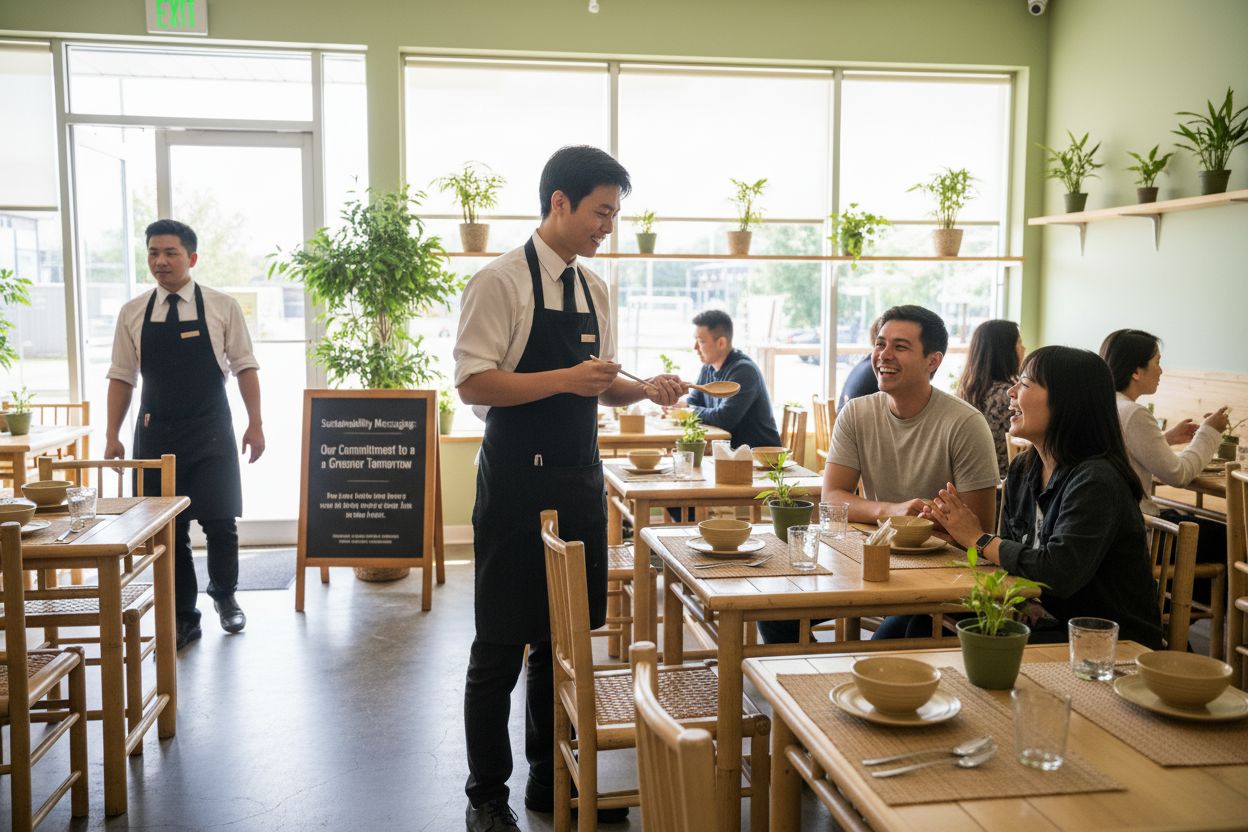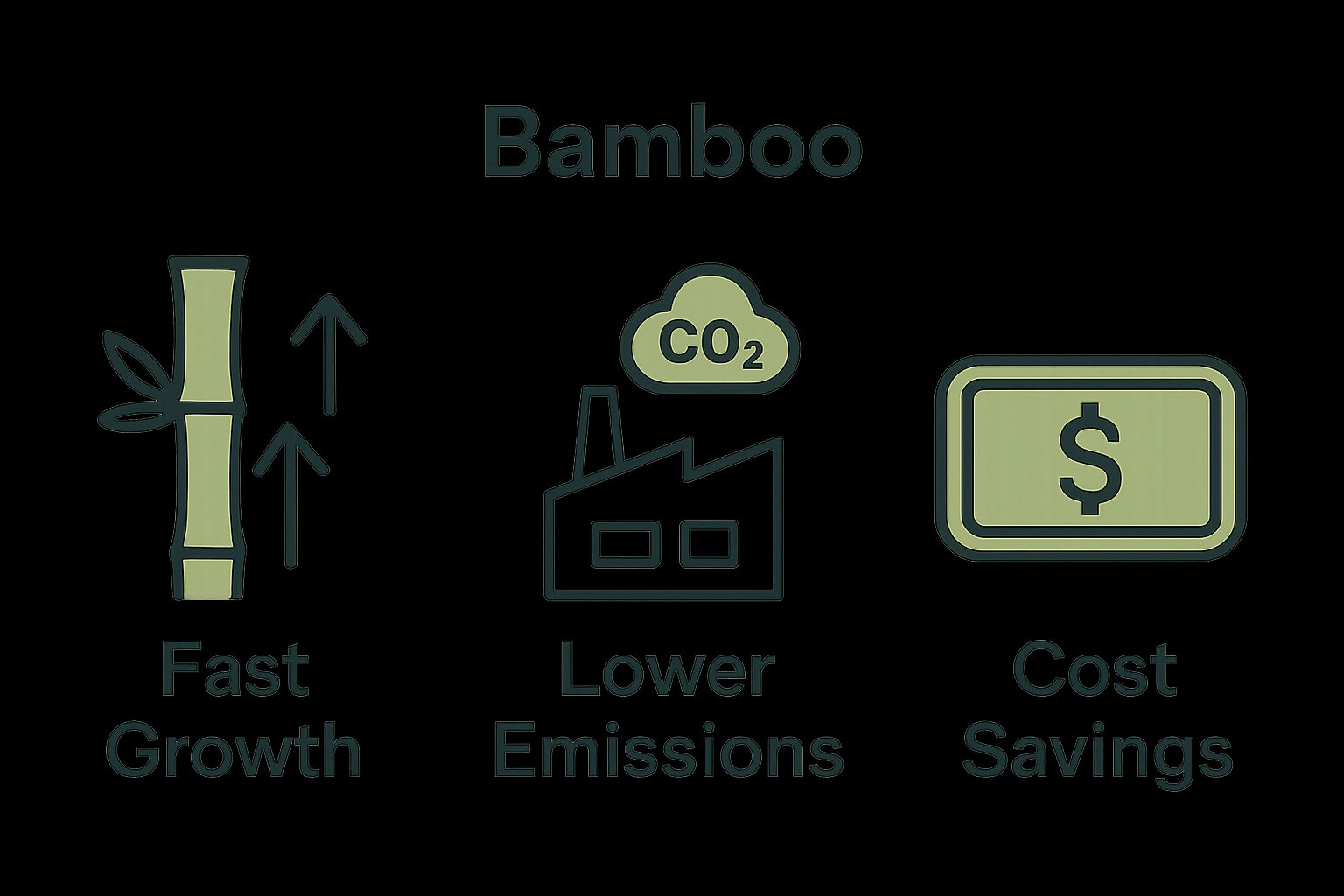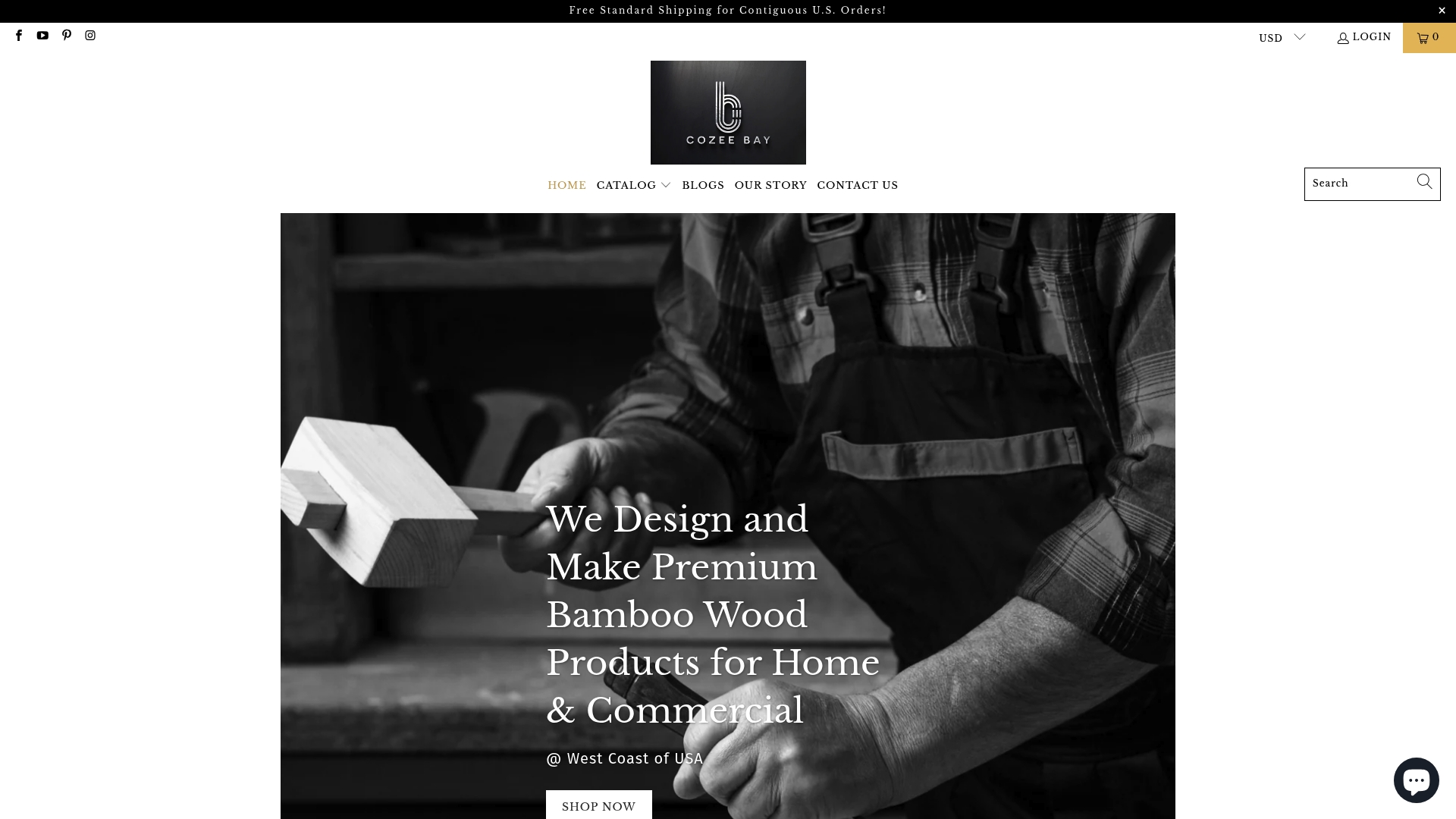Your Cart is Empty
Free Standard Shipping for Contiguous U.S. Orders!
Free Standard Shipping for Contiguous U.S. Orders!
Catalog

Understanding the Benefits of Bamboo for Restaurants
October 07, 2025 8 min read
Bamboo is popping up everywhere from eco-friendly kitchens to upscale restaurant interiors. Most people know it grows fast but the speed is staggering—some bamboo species can shoot up 36 inches in just one day. You might think all that growth just makes for cheaper furniture or greener utensils. Turns out, bamboo is shaking up the whole idea of sustainability for businesses and the planet in ways wood and plastic never could.
Table of Contents
- What Is Bamboo And Its Characteristics
- Why Is Bamboo Important For Sustainable Practices?
- How Bamboo Can Enhance Restaurant Design And Ambiance
- The Economic Benefits Of Using Bamboo In Restaurants
- Real-World Examples Of Bamboo Applications In The Restaurant Industry
Quick Summary
| Takeaway | Explanation |
|---|---|
| Bamboo grows incredibly fast | Some species can grow up to 36 inches in a single day, making it highly renewable. |
| Supports environmental sustainability | Bamboo absorbs more carbon dioxide and produces more oxygen compared to trees, aiding in climate change mitigation. |
| Cost-effective material for restaurants | Its lower procurement and maintenance costs make bamboo a financially smart choice for restaurant owners. |
| Enhances restaurant aesthetics | Bamboo’s natural warmth and versatility create a welcoming and stylish ambiance, appealing to customers. |
| Promotes local economic development | Integrating bamboo products supports sustainable supply chains and local agricultural communities, fostering economic growth. |
What is Bamboo and Its Characteristics
Bamboo represents a remarkable botanical wonder that transcends traditional plant classification. Unlike conventional trees, bamboo is actually a type of grass belonging to the Poaceae family, characterized by its extraordinary growth patterns and versatile properties. Learn more about sustainable bamboo uses.
Botanical Profile and Unique Growth Characteristics
Bamboo stands out in the plant kingdom for its incredibly rapid growth rate and exceptional regenerative capabilities. Most bamboo species can grow up to 36 inches in a single 24-hour period, making it one of the fastest-growing plants on the planet. This remarkable growth occurs without requiring replanting, as bamboo can regenerate from its own root system after harvesting.
Key botanical characteristics of bamboo include:
- Hollow, segmented stems called culms
- Extensive underground root network (rhizomes)
- Ability to grow in diverse climatic conditions
- Natural resistance to pests and diseases
Sustainability and Environmental Impact
Bamboo’s environmental credentials make it a standout material for sustainable practices. According to environmental research from Stanford University, bamboo absorbs significantly more carbon dioxide and produces 35% more oxygen compared to equivalent stands of trees. This makes bamboo an exceptional carbon sequestration tool that actively contributes to mitigating climate change.
Moreover, bamboo requires minimal water and no pesticides to grow, making it an incredibly eco-friendly resource. Its rapid growth cycle and ability to thrive in various soil conditions without depleting land resources further underscore its potential as a sustainable alternative to traditional materials.
The combination of rapid growth, environmental benefits, and remarkable structural properties positions bamboo as a revolutionary material with immense potential across multiple industries, particularly in restaurant and commercial settings seeking sustainable solutions.
Below is a table summarizing the unique botanical and environmental characteristics that make bamboo stand out compared to traditional materials used in restaurants.
| Feature/Characteristic | Bamboo |
|---|---|
| Plant Type | Grass (Family: Poaceae) |
| Growth Rate | Up to 36 inches in 24 hours (fastest-growing plant) |
| Regeneration | Regenerates from root system, no replanting required |
| Resistance | Naturally resistant to pests and diseases |
| Water and Pesticide Needs | Minimal water required; no pesticides needed |
| Carbon Sequestration | Absorbs significantly more CO₂; produces 35% more oxygen than trees |
| Soil and Climate Adaptability | Thrives in diverse climates and soil types |
| Rapid Sustainability Cycle | Quick harvest cycle; does not deplete land resources |
Why is Bamboo Important for Sustainable Practices?
Bamboo has emerged as a transformative material in sustainable practices, offering unparalleled environmental and economic advantages across multiple industries. Discover more about sustainable bamboo solutions.
Environmental Regeneration and Carbon Sequestration
Unlike traditional timber, bamboo represents a remarkable ecosystem restoration tool. According to the United Nations Environmental Programme, bamboo plays a critical role in environmental regeneration through its unique biological characteristics. Its extraordinary growth rate allows for rapid carbon absorption, with one acre of bamboo potentially capturing up to 25 tons of carbon dioxide annually significantly more than equivalent forest areas.
Key environmental restoration attributes include:
- Rapid soil stabilization and erosion prevention
- Enhanced biodiversity support
- Natural water filtration capabilities
- Minimal land degradation during cultivation
Economic and Industrial Sustainability
Bamboo offers substantial economic benefits beyond environmental advantages. The material provides a renewable alternative to traditional resources, enabling industries to reduce their carbon footprint while maintaining production efficiency. Its versatility allows for applications ranging from construction materials to kitchen accessories, creating economic opportunities in sustainable manufacturing.
The economic potential of bamboo is particularly significant for restaurants and commercial enterprises seeking eco-friendly solutions. By integrating bamboo products, businesses can demonstrate environmental responsibility while accessing durable, cost-effective materials that align with modern sustainability expectations.
Through its remarkable regenerative capabilities, minimal environmental impact, and broad industrial applications, bamboo represents more than just a material it symbolizes a comprehensive approach to sustainable development that balances ecological preservation with economic innovation.
How Bamboo Can Enhance Restaurant Design and Ambiance
Bamboo transcends its material properties to become a powerful design element that transforms restaurant spaces into inviting, contemporary environments. Explore creative bamboo decor solutions that can revolutionize restaurant aesthetics.
Visual Aesthetics and Natural Warmth
According to interior design research from the American Society of Interior Designers, natural materials like bamboo create a sense of organic warmth and authenticity in commercial spaces. Its unique grain patterns and subtle honey-toned colors provide a visually sophisticated backdrop that can complement diverse design styles from minimalist to rustic.
Key design characteristics of bamboo include:
- Versatile color palette ranging from light blonde to rich amber
- Naturally elegant grain patterns
- Ability to blend with multiple design aesthetics
- Lightweight yet structurally robust appearance
Functional Design and Sustainability Messaging
Beyond aesthetic appeal, bamboo serves as a strategic design choice that communicates a restaurant’s commitment to environmental responsibility. Integrating bamboo elements like utensil holders, menu stands, table surfaces, and decorative screens signals to customers that the establishment prioritizes sustainable practices.

Restaurant owners can leverage bamboo’s design flexibility to create distinctive spaces that tell a story. From intricate wall paneling to minimalist serving trays, bamboo offers unlimited design possibilities that transform dining environments into immersive experiences that engage customers both visually and philosophically.
Ultimately, bamboo represents more than a material choice it is a design philosophy that harmonizes aesthetic beauty, environmental consciousness, and functional innovation in restaurant spaces.
The Economic Benefits of Using Bamboo in Restaurants
Bamboo offers restaurants a powerful economic strategy that balances cost-effectiveness with sustainability, transforming traditional business models into environmentally conscious enterprises. Explore innovative bamboo product solutions.
Cost Efficiency and Long-Term Savings
According to research from the United Nations Food and Agriculture Organization, bamboo presents a significantly more economical alternative to traditional materials used in restaurant settings. Its rapid growth cycle and minimal cultivation requirements translate into lower procurement costs compared to hardwood alternatives.

Key economic advantages for restaurants include:
- Reduced material acquisition expenses
- Lower maintenance and replacement costs
- Increased durability of restaurant fixtures and utensils
- Minimal waste generation during production
Supply Chain and Local Economic Impact
Beyond direct cost savings, bamboo integration offers broader economic benefits. Restaurants investing in bamboo products contribute to sustainable supply chains that support local and global economic development. By choosing bamboo, establishments can potentially reduce their carbon footprint while simultaneously supporting agricultural communities that cultivate this versatile material.
The economic model of bamboo is particularly compelling for restaurants seeking to differentiate themselves in a competitive market. Customers increasingly value businesses that demonstrate environmental responsibility, making bamboo investments both an ecological and strategic financial decision.
Ultimately, bamboo represents more than a material choice it is a comprehensive economic approach that aligns environmental stewardship with financial innovation in the restaurant industry.
The following table highlights economic and environmental benefits bamboo offers for restaurants, organizing key concepts for easy comparison.
| Benefit Category | Bamboo Advantage |
|---|---|
| Cost Efficiency | Lower procurement and maintenance costs vs. hardwoods |
| Durability | Increased durability of fixtures and utensils; reduces replacement frequency |
| Rapid Renewal | Fast growth and quick harvest cycles for reliable supply |
| Environmental Impact | Reduces carbon footprint, absorbs more CO₂, generates minimal waste |
| Supply Chain Impact | Supports sustainable supply chains and local agricultural development |
| Customer Appeal | Communicates commitment to sustainability, attracting environmentally conscious customers |
| Design Flexibility | Suitable for a wide range of aesthetics and interior applications |
Real-World Examples of Bamboo Applications in the Restaurant Industry
Bamboo has emerged as a transformative material across diverse restaurant environments, demonstrating remarkable versatility and innovative potential. Discover commercial bamboo product applications that are revolutionizing dining experiences.
Dining Accessories and Service Implements
According to architectural design research from the International Bamboo and Rattan Organisation, bamboo is increasingly utilized in restaurant settings through practical and aesthetically pleasing accessories. From chopsticks and serving trays to menu holders and utensil containers, bamboo provides a sustainable alternative that enhances dining experiences.
Key practical applications include:
- Lightweight yet durable serving implements
- Elegant tabletop decorative elements
- Eco-friendly disposable and reusable dining tools
- Customizable design options for different restaurant themes
Architectural and Interior Design Integration
Progressive restaurants are incorporating bamboo beyond mere accessories, utilizing the material in structural and design elements. Bamboo wall panels, decorative screens, furniture, and even entire architectural facades demonstrate the material’s potential to create immersive, environmentally conscious dining environments.
From minimalist sushi restaurants in urban centers to rustic farm-to-table establishments, bamboo provides a versatile design language that communicates sustainability, authenticity, and innovative thinking. Restaurants can leverage bamboo to create unique spatial experiences that resonate with environmentally aware customers.
These real-world applications illustrate bamboo’s transformative potential not just as a material, but as a comprehensive design philosophy that reimagines restaurant spaces through sustainability and aesthetic innovation.
Upgrade Your Restaurant’s Cleanliness and Style with Bamboo Innovation
Busy restaurants face a constant challenge balancing sustainability and durability for high-traffic essentials. You have learned how bamboo’s natural strength, fast regeneration, and eco-friendly characteristics help create stylish, sustainable dining spaces. Yet, achieving both a clean environment and an impressive aesthetic can still feel difficult, especially with traditional dispensers that wear out or make the wrong impression.
Discover how Cozee Bay’s Bamboo Paper Towel Dispensers solve this exact need. Our handcrafted bamboo solutions combine superior durability, elegant design, and environmental responsibility. Restaurants nationwide trust these dispensers to withstand constant use while sending a powerful message about their green values.

Ready to elevate your restaurant’s look, hygiene, and sustainability all at once? Visit Cozee Bay to view our full line of eco-friendly paper towel dispensers and other versatile bamboo products. Make the switch today and feel confident knowing your business supports a cleaner planet and delivers a standout experience for your customers. Shop now to enjoy free shipping and a money-back guarantee while supplies last.
Frequently Asked Questions
What are the primary benefits of using bamboo in restaurants?
Bamboo offers numerous benefits for restaurants, including cost efficiency, durability, sustainability, and aesthetic appeal. It’s a rapidly renewable resource that can lower material costs and reduce environmental impact, making it an excellent choice for eco-conscious establishments.
How does bamboo contribute to a restaurant’s sustainability efforts?
Bamboo helps restaurants enhance their sustainability efforts by serving as an eco-friendly material that requires minimal water and no pesticides to grow. Its rapid growth cycle allows for better carbon absorption, effectively contributing to carbon footprint reduction and environmental responsibility.
Can bamboo be used in various design styles for restaurants?
Yes, bamboo is highly versatile and can complement a range of design styles, from minimalist to rustic. Its natural grain patterns and warm color tones make it suitable for various aesthetics while maintaining an organic feel in restaurant environments.
What practical applications does bamboo have within a restaurant setting?
Bamboo can be utilized in many practical applications within restaurants, including dining accessories like utensils, serving trays, menu holders, and decorative screens. Its lightweight and durable nature make it an ideal choice for everyday use in dining settings.
Recommended
Leave a comment
Comments will be approved before showing up.
Subscribe
Sign up to get the latest on sales, new releases and more …

